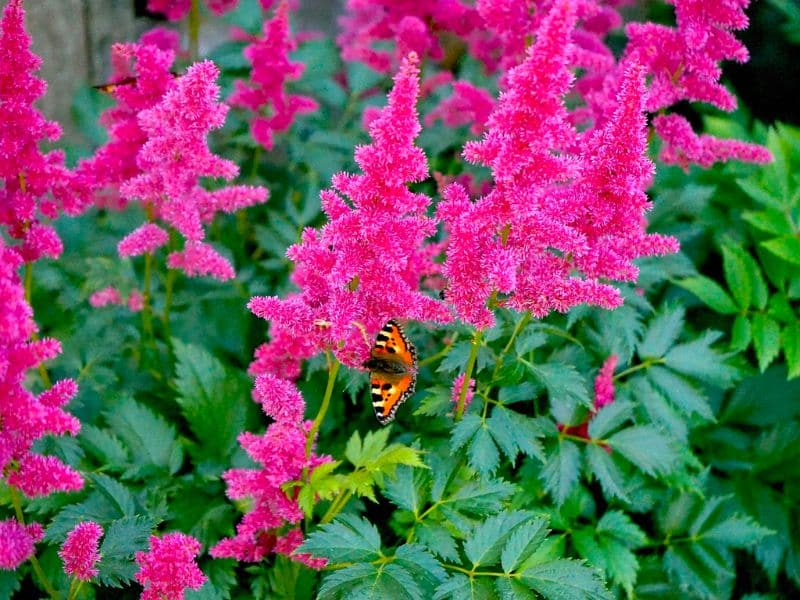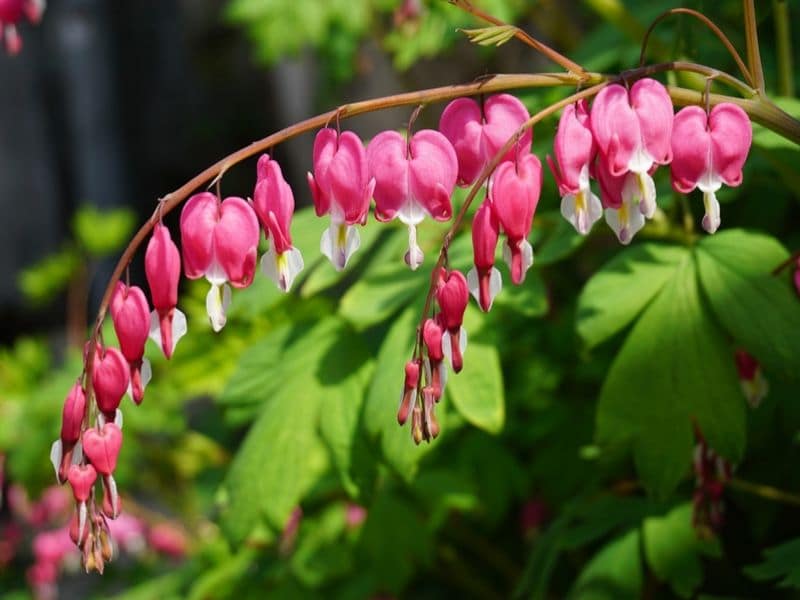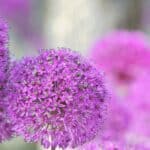Astilbe flowers (Astilbe chinensis), also known as false goats beard, are members of the saxifragaceae family and are some of the strangest plants you can add to your garden. These perennials produce brightly colored feathery flower plumes that remind of cotton candy or a goat’s beard.
There are 18 different species of this perennial herb with colorful plumes in shades like pink, white, deep red, lavender, violet, and others on dark green foliage. These blooms usually start in late spring and until early summer and will add lots of cheer and texture to your garden bed.
Gardeners love to pair astilbes with companion plants because certain combinations will make these flowers pop in color.
In this guide, we will look at some of the best astilbe companion plants to grow if you want to create a striking garden design.

What to Plant with Astilbes
Astilbe flowers prefer light to deep shade conditions but will only flower if you establish them in dappled shade. In full sun, the foliage of these plants will quickly wilt. These perennials must also be kept moist but established in well-draining soil.
The right companion plants will also grow well in these shaded and moist conditions. Let’s look at other beautiful flowers and foliage varieties that can grow well beside your astilbe plants.
Japanese Painted Fern

The Japanese-painted fern (Athyrium niponicum), also known as lady fern or Japanese lady fern, is a terrific companion plant to add to your garden bed because the fern-like foliage of astilbes will look rather striking next to the purple-silver hue of this fern.
This is also a good combination because the lady ferns will keep your garden nice and full when the astilbe flowers die back for the winter.
Lady ferns will grow well in your shade garden. These plants grow well in free-draining soil and flourish in the moist soil your astilbe flowers require.
When pairing lady ferns with astilbes, it is usually best to grow them in the front because they are slightly shorter, with a maximum height of just 24 inches. When these ferns are in the front, they will also create a good barrier to conceal the dying foliage of your astilbes during fall.
Feathery Ferns

Feathery ferns (asparagus setaceus), also known as asparagus ferns, lace ferns, climbing asparagus, or asparagus grass, are great companion plants to consider if you want to maintain that feathery soft feel throughout your garden bed.
These plants are popular in ornamental gardens because they produce lime-green foliage with a feathery, soft texture. This foliage’s vivid green and soft look will look rather striking alongside the feathery tips of any of the astilbe varieties.
Feathery ferns are shade-loving perennials that love moist, loose soil that drains well.
These ferns should be planted in the back of your garden because they can grow up to 2.5 meters tall.
Rhododendron

Rhododendrons (Rhododendron spp), also known as azaleas, are a good option for sunny gardens because this plant will create plenty of shade for your astilbes.
Rhododendrons are evergreen shrubs or small trees that produce many vivid flower clusters and come in many different colors.
These shrubs can be grown in direct sun if planted in soil that drains well. The hardy perennials also require frequent watering.
It is best to grow your azaleas in a garden center with lots of astilbes in the shady spot this small tree will create. The plume-like flowers of astilbes and clusters of rhododendrons will create a striking look because these plants have a similar bloom time.
Bleeding Heart

The bleeding heart flower (Lamprocapnos spectabilis) is a favorite in shade gardens and an excellent astilbe companion plant if you want to create a striking backdrop.
These plants produce many delicate heart-shaped flowers in colors like pink, white, and white and soft foliage that can add texture to your garden bed.
Bleeding hearts grow their best in shady spots and must be placed in humid soil with lots of organic matter.
These flowering shrubs can grow up to 3 feet tall and should be positioned behind the area where you grow astilbes.
Coral Bells

Coral bells (Heuchera spp) are excellent companion plants to include in a shade garden because they can add lots of color with their colorful leaves, and the evergreen shrubs will do a great job at hiding the fading foliage of astilbes during winter.
These shrubs have glossy leaves in shades like red, purple, green, peach, and many others. They will look striking next to astilbe varieties like astilbe simlicifolia or japonica, especially when they bloom simultaneously with your false goat’s beards. You can expect many tiny flowers on tall spikes from late spring and summer.
The shrubs grow well in partial shade in free-draining but slightly acidic soil.
Coral bells are short and can quickly be grown next to your astilbes. You can also combine different varieties of coral bells for a more exciting effect.
Holly Fern
Holly ferns (Cyrtomium falcatum), also known as Japanese holly fern, are another good companion to grow with astilbes.
The light green leaves of this fern will add lots of texture to your garden and will complement the delicate leaves of your astilbe blooms very well.
As with most ferns, this one is also evergreen, it will grow well in a shade garden and prefers soil that is kept moist but drains well or in rock gardens.
Holly ferns can grow up to two feet tall. Because of its height, it is best to establish it behind your other plants.
Hostas

Hostas (Hosta), also known as plantain lilies, can be great companions for astilbes. Hostas come in various colors, and one of the most interesting to pair with astilbes is blue hostas because their blue-tinted leaves will look immensely striking next to the cool tones of astilbe flowers.
As with most plants that prefer a shady spot, these plants prefer soil that is kept moist but doesn’t get too soggy.
Establishing your hostas behind your astilbe flowers is best because these companion plants can grow quite densely with a maximum height of up to four feet.
What NOT to Plant with Astilbes
Astilbes are delicate plants that cannot tolerate too much sun or dry soil. If you pair these flowers with sun-loving plants like black-eyed susans, bee balm, or coneflowers, either one or the other will die because it is impossible to find sunlight and watering balance when you pair such different species in the same bed.
It is best to avoid all sun-loving plants and any plants that cannot tolerate high humidity levels.
Final Thoughts
Astilbes can look quite stunning if you pair them with texture-rich plants like ferns, hostas, coral bells, or colorful flowers like bleeding hearts. We are certain that any of these combinations we discussed in this article will help you create a very beautiful garden and that your astilbe blooms will look vivid and striking next to these plants.







